Last year we reviewed the iBlue 757 Solar Bluetooth GPS receiver. I am not really sure if that receiver made it into public life.
In any case Semsons have asked me to review the successor, dubbed iBlue 757 PRO or i.Trek Z1, depending on where you look. In Europe the receiver is distributed by Keomo, who partner with Widget in the UK. 
We briefly mentioned the receiver already in our news item, calling it the
"Swiss Army Knife".

The reason for that is that the Z1 packs pretty much every single feature that you have seen in other receivers into one device. Namely
- 32 channel MTK chipset
- Bluetooth Serial Port
- Bluetooth Sleep mode
- Solar Panel
- USB Mouse mode (new to the PRO)
- Data Logger for 30000 datapoints. (new to the PRO)
The 757 did already show some impressive performance, let's see if the 757 PRO can live up to that reputation.
From a case design point of view there are only two small differences. The 757 PRO lacks the external antenna connector of the 757 (not that I would miss it) and the on/off switch now has three positions: LOG, NAV, and OFF.
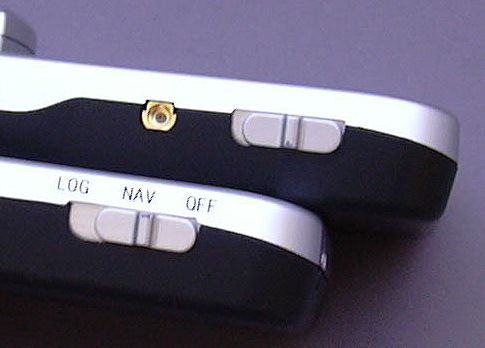
This slider switch is not exactly well designed. The current position is not "NAV" as one might think, but "OFF". The "NAV" position is quite difficult to get to - most of the time you end up in either "OFF" or "LOG".
I also noticed that the protective plastic cover of the solar panel is gone. The panel is now exposed directly. While this improves the light collection performance it also exposes some gaps in the case and increases the risk of damaging the panel - I didn't like that part.
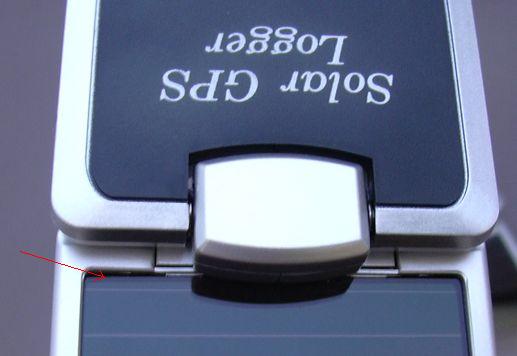
I guess by now it is clear that the Z1 is not watertight, not even waterproof against splashes. This does contradict the idea of an always exposed receiver and makes the Z1 less suitable for outdoors activities.
The battery is the same as in the original receiver - the Nokia BL-5C. The battery comes in varying capacities (here provided is the 1000 mAh version, but you can get up to 1100 mAh types). Since this battery type is so ubiquitous the receiver runtime can be extended easily and cheaply - there is no excuse for not carrying a spare battery with you.
My review unit complained about a nearly empty battery after just a few hours of running - I am not sure if the battery itself is to blame or if the firmware is too cautious. In any case the battery lasts xxx hours after a full charge, without sunlight, and with permanent GPS and Bluetooth traffic.
One thing I do not like is the imprint on the cover. Not only does it look cheap, it also defeats the idea of a, uhm, covert operation. The to-be-tracked offspring for example could be told that this is just a Bluetooth receiver, and the logging function could be conveniently omitted from the story. Alas, the imprint makes that obvious to everybody and blows the cover (yes, the switch contributes too). I wanted to try the sugar cube trick to remove the silver text but to my surprise there are no sugar cubes available in the US, at least not in the area where I live.
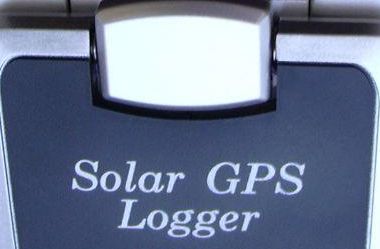
Receiver Performance
Here are the results of the cruelty test. The first three graphs are for the NAV mode, the last three for the LOG mode.
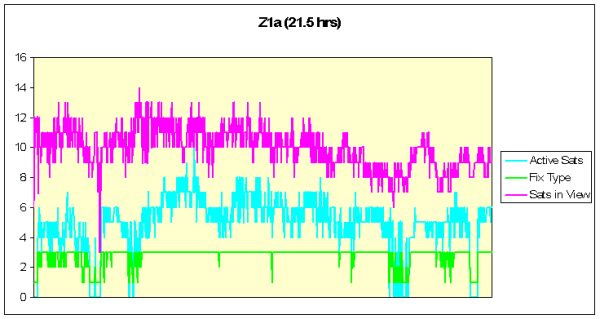
Just to re-emphasize - this data is collected from a receiver that has not got a fair chance to get and hold a fix. It was sitting behind coated glass, with very little sky view. The green graph on the top is the fix type. 3 means 3D, 2 means 2D, and 1 means no fix.
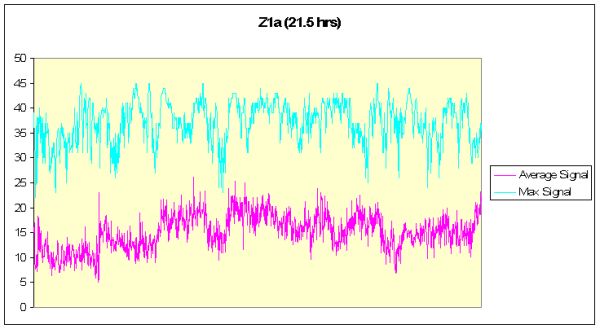
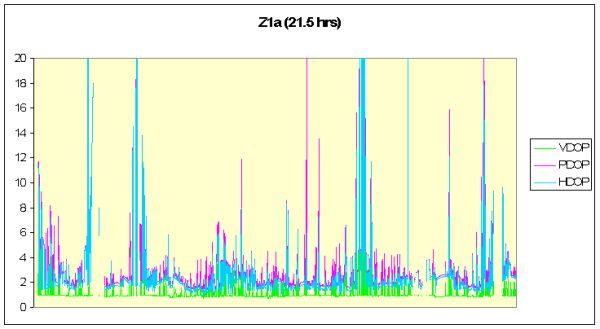
In LOG mode the receiver worked for about half an hour less.
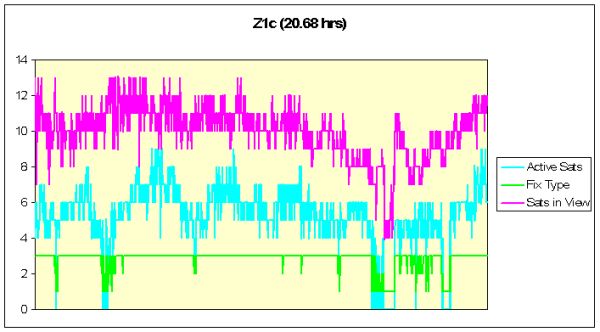
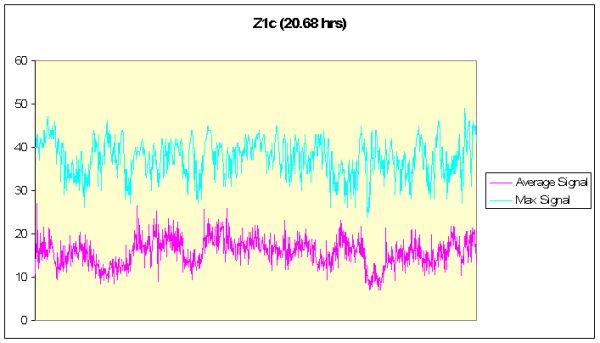
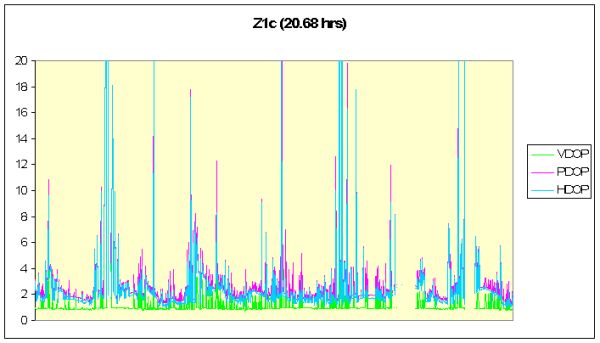
The DOP values are most impressive for that hostile environment.
The software
Since the 757 Pro has a data logging feature you also need some way to get the data out of it. You can retrieve the data and configure the unit either via Bluetooth or via USB.
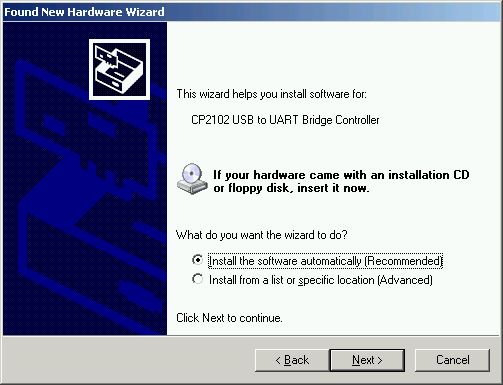
The receiver has the USB to Serial bridge built in, it uses the pretty common CP2102 chip. I had the driver for that chip already installed for another device so I could re-use the existing driver. You can either use the driver from the companion CD or get it from the internet.
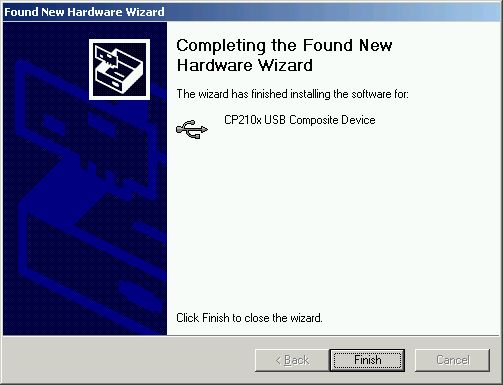
After installation is finished and the device is connected and switched on you will find a new serial port in your computer's device manager. Make a note of the COM port number (here COM4)
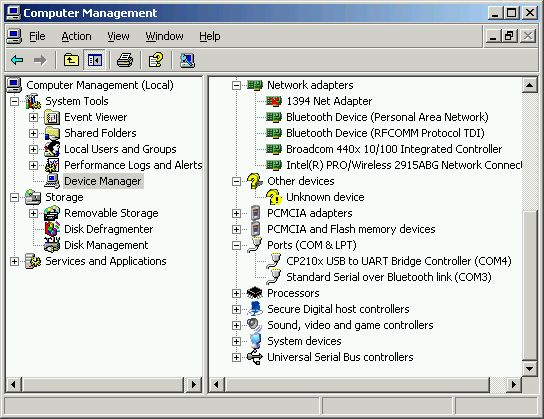
Next is the installation of the logger program. Then you can start the logger program and begin to configure the data logger.
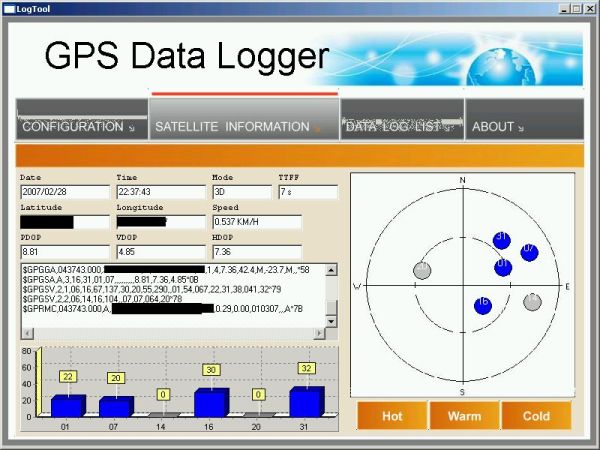
The control program locks up when you leave the mode switch in NAV mode. Make sure to move the switch all the way towards LOG in order to avoid this issue.
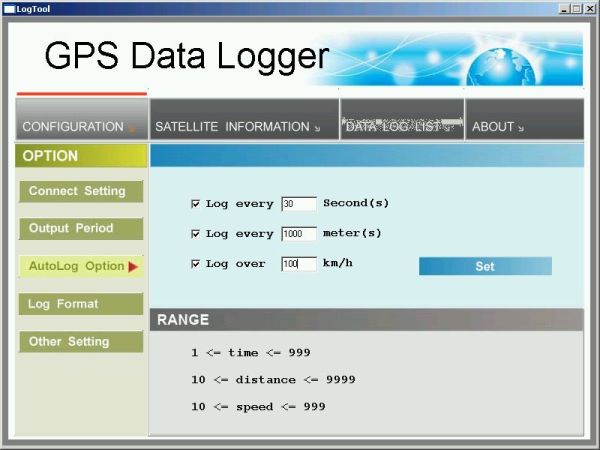
As usual, logging can be done by time interval and by distance. A new feature is the ability to log above a certain speed. This can be used as a motion sensor, but also to track a speeding offspring who promised not to drive faster than 100 km/h. Imperial measures are not known to the program, by the way.
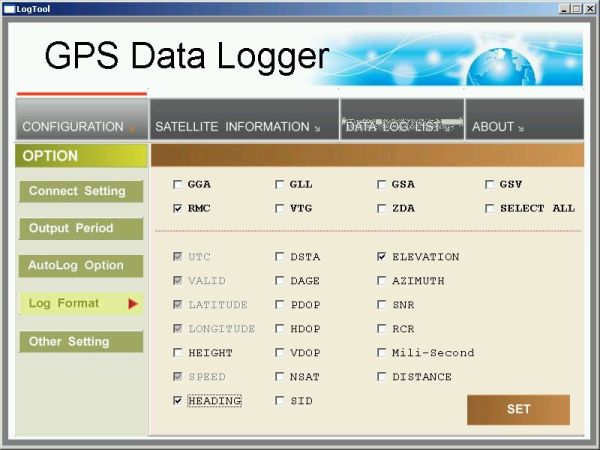
The logging configuration is very interesting. Unlike with other data loggers here you can decide for each NMEA sequence how frequently it should be recorded. If you are unsure which settings are activated you can glean at the "data log list" tab, the current settings are listed at the top.
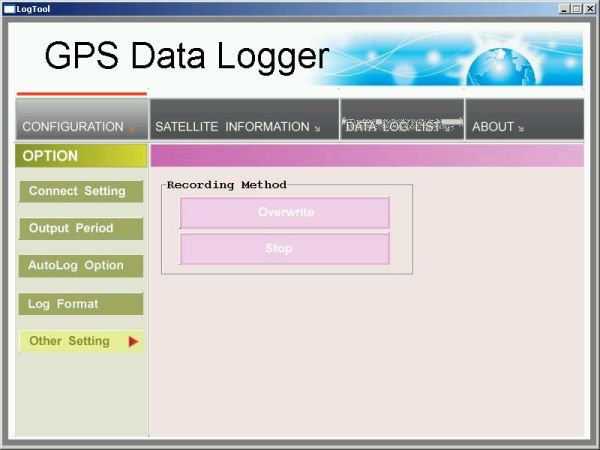
When the log memory is full you can decide if you want to stop logging or if you want to overwrite the oldest data.
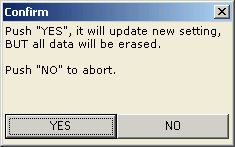
After you have configured the device you need to save the new configuration. Unfortunately this will also erase the existing data. I can't see the reason for that, configuration and existing data should not interfere.


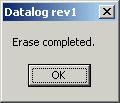
If you get the error message you need to move the mode switch all the way to "LOG" and then try again.
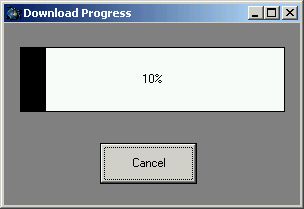
Once you have collected a few data points it is time to retrieve them. The control program always downloads the whole memory, regardless of how many data points are actually recorded, This is very inconvenient as it takes 8 to 10 minutes to read all the 30000 potential data points. (The marketing text claims 50000 data points but my experience does not support that).
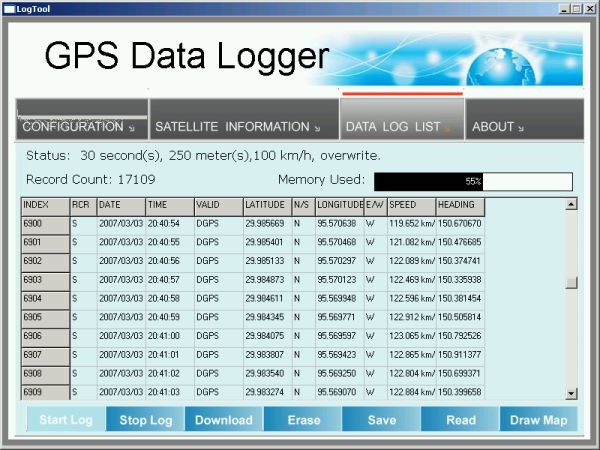
And if you then want to display all the data at once you will be met with the next inexplicable hurdle.
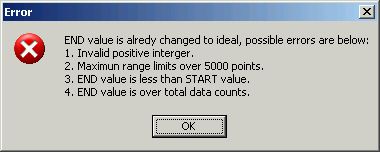
You can only display 5000 data points at a time. Why !?!?
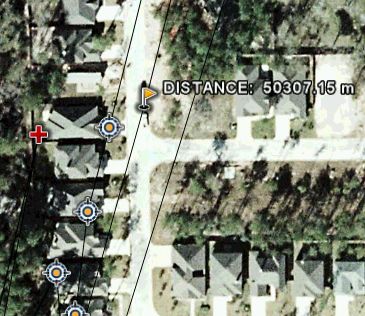
Example of a distance triggered log item.

Example of a time triggered item.
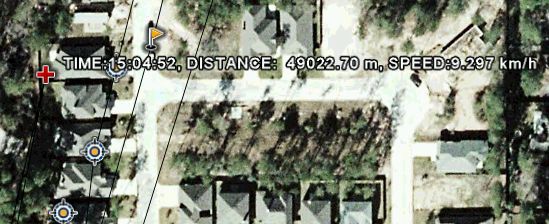
Example of a start point. Let's rephrase that. I have no idea what the cross stands for.
Other Oddities
The manual and the packaging mention a push-to-log button. However, the Z1 does not have any buttons. Most likely the user manual for the 747 has been re-used without checking for the differences (the 747 does have a push-to-log button)
Since there is no button, how can you log a single point? A - somewhat crude - solution is to move the slider to the log position and back.
The one problem with the hardware power switch and mode selector is that if you let the device run out of battery then the solar cell will not be able to recharge the receiver - since the device is still switched on it will eat up all the energy collected by the solar cell. Here a software power button would have made sense, particularly if you keep the receiver in the car , using it only occasionally, and allowing it enough time (and sun) to recharge the battery in between usages.
The driver CD is a mini-CD which is not helpful when your computer has a vertical CD-ROM drive. It would have been better if a standard size CD would have been provided. On the other hand the CP210x driver for the very common USB-to-Serial bridge can also be downloaded from the internet. That won't give you the logging features but at least you could already use the Z1 as a USB GPS.
I have already mentioned that the locations of the solar panel and the GPS antenna do not make sense to me. In my mind the moving part should contain the solar panel to make directing the panel towards the sun easier. The GPS antenna works best when lying flat on a surface.
Maybe it is even possible to position the GPS patch antenna _under_ the solar panel?
Conclusion
The addition of USB GPS mode and of the data logger have made a good product even better. Some of the battery runtime has been sacrificed for better performance (left:757, right: Z1/757Pro)
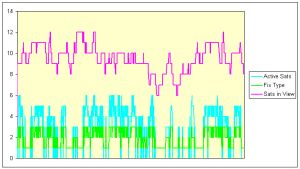
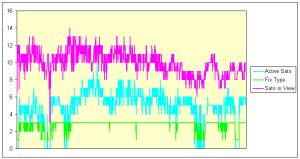
but it is still impressive at 20 hours without solar cell support.
At CeBIT we have seen mockups of the next generation solar cell receiver, and in a few months we will be getting a review copy of that. Until then the Z1/757PRO is a very good choice if you are in the market for an all-in-one GPS receiver.